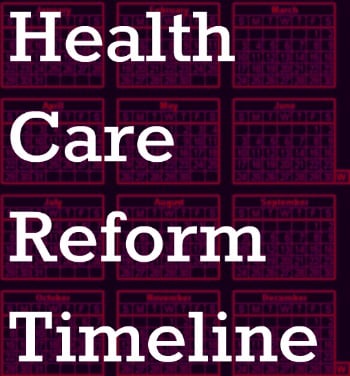
BARB RAND
Compliance Advisor
On March 23, 2010, President Obama signed into law the Patient Protection and Affordable Care Act — aka Obamacare, or, more bluntly, the health care reform that's been keeping everyone on their toes. This law has changed the health care system as Americans know it.
Because 2014 still is pretty fresh, we think it's a good time to look at some of the items coming down the road this year — and beyond — in health care reform. This health care reform timeline for employers is a handy companion for long-term planning.
What's New in 2014
This year is a big one for health care reform. Here's a look at what's coming your way:
Health insurance tax: An $8 billion small business health insurance tax starts on the fully insured market, where most small businesses buy their coverage.
Exchanges up and running: The public health exchanges start, offering coverage to qualified individuals and small employers.
Insurance for the poor: Premium tax credits and subsidies get under way, and the federal government starts subsidizing health insurance for people whose income is lower than 400 percent of the federal poverty rate and, with respect to premium tax credits, do not have access to other affordable minimum value coverage.
Insurance is mandatory: The individual mandate starts. People must have minimal essential coverage or pay a penalty, starting at $95 per person per year or 1 percent of household income, whichever is greater.
No discrimination: Insurance plans cannot make exclusions based on pre-existing conditions or the costs of certain items and services furnished in connection with participation in clinical trials for life-threatening diseases (i.e., cancer) or charge higher rates because of health status.
Health Care Reform Through 2018
Decision makers need to take the long view for optimal success. Here's how health care reform is set play out (unless there are more delays):
2015
Employer mandate: Large businesses must offer health insurance or pay penalties. The penalties are based on the number of FTEs; whether the insurance offered qualifies as minimal essential coverage and is affordable; and whether any employees receive government subsidies for health coverage. The penalty is up to $2,000 annually for each full-time employee. (Pay or play health care reform was supposed to take effect in 2014, but the Treasury Department announced its decision to delay enforcement to 2015 in summer 2013.) To avoid a penalty, applicable large employers must offer affordable minimum coverage to at least 70 percent of their full-time employees until 2016, when the number increases to 95 percent.
Taxes go up: The small business health insurance tax increases to $11.3 billion.
Individual mandate increases: The individual tax penalty for failing to have health coverage rises to $325 per person or 2 percent of income, whichever is greater.
Small business exchanges start: The Small Business Health Options Program (aka SHOP), which were delayed in spring 2013, are up and running. The state SHOP exchanges must offer employer choice (where employers can pick from multiple health insurance plans to offer employees) or employee choice (where employers can offer a certain coverage level (bronze, silver, gold, platinum) to employees).
Report and verify: Large employers that offer minimum essential coverage must report about the coverage that they offer, and to whom the coverage is offered. Information is to be sent to the IRS as well as individuals covered by the Plan. This was originally scheduled for 2014 but was later made voluntary for 2014.
2016
Taxes hold steady: The small business health insurance tax stays at $11.3 billion.
Report and verify: Large employers must prove they offer affordable and adequate health coverage.
Individual mandate increases: The penalty rises again, this time to $695 per person or 2.5 percent of income, whichever is greater.
SHOP expands: The small business exchanges must open to businesses with up to 100 employees.
Small group definition: The national definition of small group market now includes businesses with up to 100 employees. This change will require more businesses to offer essential health benefits and comply with other insurance market reforms. NOTE: Prior to 2016, states determine the definition of small group market and, in the case of some states, the definition of small group is already at 100.
Employer mandate: Not-so-large employers (50-99 full-time employees) now must comply with the employer mandate.
2017
Taxes increase: The small business heath insurance tax rises to $13.9 billion.
Individual mandate levels off: The penalty is based on 2016 levels, and now will increase with cost-of-living adjustments.
2018
Cadillac tax: Employers must pay a 40 percent high-cost plan excise tax on the cost of coverage for plans that exceed $10,200 for individual coverage or $27,500 for family coverage. The goal of the tax is to finance and slow health care costs.
Taxes increase: The small business health insurance tax rises to $14.3 billion.
There's no shortage of items for your calendar when it comes to the Affordable Care Act. What are your go-to sources for staying on top of deadlines and what's next? How could this health care reform timeline for employers be more useful? Please share in comments!
DISCLAIMER: We hope this blog post gave you an "Aha!" moment, but please don't hold it as legal or tax advice. This information is general in nature, and your specific situation deserves attention from a dedicated legal or tax advisor.
Related Posts:
2 Real World Examples of ACA-Compliant Wellness Programs
What Public Exchanges are Doing to Employer-Sponsored Health Coverage
"Use It or Lose It" Rule for FSAs Goes Away
How to Help Employees Navigate Obamacare
.png?width=69&height=53&name=Acrisure%20Logo%20(White%20Horizontal).png)


